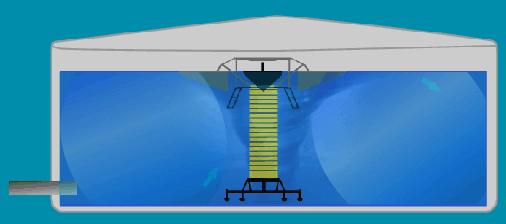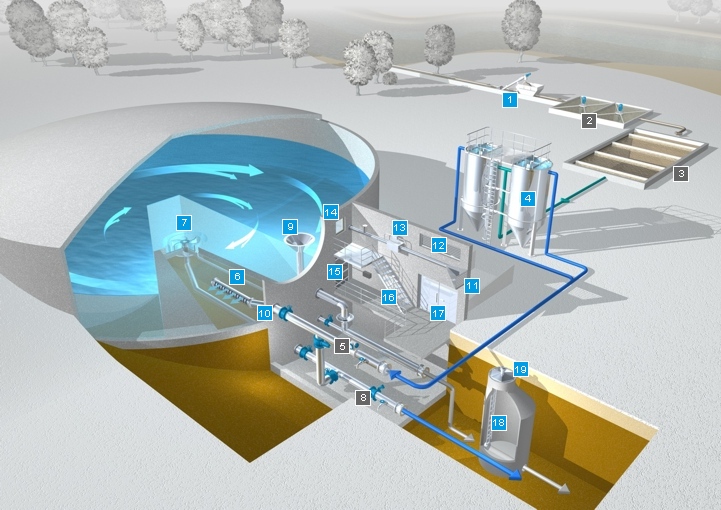

SERVICE RESERVOIRS
Water Treatment Reservoirs
Water supply sources, such as wells or water treatment plants, operate best at steady, design rates over relatively longer periods of time. However, demand in the water treatment distribution system constantly fluctuates. Most water treatment distribution systems experience short-term peak demands, which exceed the available rate of supply. Service reservoirs provide a suitable reserve of treated water to supply to the shortfall in the water treatment distribution system during the peak demand.
1. Functions of Service Reservoirs
Service reservoirs are provided in the water treatment distribution system for the following functions:
-
To equalize the variation in hourly demand of water by the consumers to a uniform rate of supply from the source either by gravity or pumping,
-
To maintain the desired minimum residual pressure in the distribution system,
-
To provide the required contact time for the disinfectant added in order to achieve effective disinfection, and
-
To facilitate carrying out repairs either to the pumping main or to pump-set without interruption to the supply of water.
2. Types of Storage Reservoirs
Service reservoirs can be of two types; balancing reservoir and service reservoir. Further they can be either elevated reservoir (ER), also called over head tank (OHT) or ground level reservoir (GLR), also called underground sump. ERs provide the necessary pressure in the distribution system while GLRs serve as suction sumps for pumps.
ERs are more reliable storage structures than GLRs as they maintain supply even in the event of pump breakdown. They allow simple control of operation of pumps in filling the tank. Though they are more expensive, they are desirable because of their reliability in meeting the short-duration high-demand rates through gravity flow.
-
Service Reservoirs
In case the supply from the source is not continuous for all the 24 hours and only during certain duration by pumping for 12 to 20 hours in a day and the water distribution is intermittent for certain specified hours different from the pumping schedule, the supply from the source is stored in a storage reservoir and then supplied to the consumers according to the schedule. This type of storage reservoir is called service reservoir (SR). The SR is provided with separate inlet and outlet connections with control valves.
-
Balancing Reservoir
When the supply from the source is continuous for all the 24 hours, the water transmission main is connected directly to the distribution system or different service reservoirs with a branch to a storage reservoir. During the lean demand period the excess supply from the source is stored in the storage reservoir. During peak demand in the distribution system, water from the source as well as from the storage reservoir will be supplied. The storage reservoir under this condition is called Balancing Reservoir. Balancing reservoir is also called floating reservoir. Only one pipe is connected to the reservoir, which will act as inlet as well as outlet. In a water supply system with number of service reservoirs one for each zone, they can be connected to a master balancing reservoir (MBR) so that the proper distribution of water to each of the SRs can be achieved by supplying through independent feeder mains.
The only difference between balancing reservoir and service reservoir is the inlet and outlet arrangement. The balancing reservoir has a single connection to serve as inlet as well as outlet, while service reservoir has separate inlet and outlet connections. Other components of both balancing reservoir and service reservoir are identical
-
Underground Reservoirs
Underground reservoirs, also known as sumps serve as suction sources for pumps. These reservoirs normally are built at the site of a supply source. It is common to design a well pump station where number of well pumps discharges to an onsite reservoir. Water treatment plants also commonly have large reservoirs to hold treated water. Service pumps draw water from the reservoir and discharge into the transmission and distribution system. The reservoir at the water treatment plant or well source can be either completely buried, partially buried or completely above grade. The onsite reservoir at each well site can help to solve potential water quality problems. Water discharged from wells often contains dissolved gases and silt or grit. If this water goes through a reservoir, the gases will dissipate and the grit will settle to the reservoir bottom and these problems could be eliminated. These underground reservoirs can also be used to provide storage for a portion of the overall storage volume needed in the system.
3 Storage Volume of Reservoirs
The volume of water storage needed depends upon the following:
-
Maximum rate of peak hourly demand,
-
Maximum rate of pumping, and
-
Duration and actual schedule of pumping and distribution in a day.
Volume of storage to be provided in the reservoirs and the rate of pumping are so fixed to permit the pumping at average rate during the period of maximum demand. For electrically operated pumps, the maximum duration of pumping is limited to 20 hours in a day leaving 4 hours rest during lean demand period. However, two shifts of 8 hours each totaling 16 hours pumping is commonly adopted. In very large water supply systems three shifts of 8 hours pumping, totaling 24 hours with dedicated electrical feeder line for power supply is practiced considering the economics of the transmission main. Diesel generators are also provided at the pumping station as redundant power to facilitate uninterrupted operation of pumps.
The general norms for volume of storage required with reference to duration of supply from the source are listed in Table
Volume of Storage Required
| Duration of Supply or Pumping | Volume of Storage as percentage of daily requirement |
| Above 16 to 24 hours | 20 to 25% |
| Above 12 to 16 hours | 33.33% |
| Above 8 to 12 hours | 50% |
| Less than 8 hours | 100% |
The optimum volume of water treatment storage in the reservoirs can be determined from the duration of supply and the actual demand during different time period of distribution using the mass diagram method. The day is divided into number of periods of different rate of demands. For each of the durations the demand, the supply, cumulative demand, cumulative supply and cumulative deficits are worked out. The volume of water treatment storage required is the absolute sum of the maximum positive and negative cumulative deficits. This volume of water treatment storage should be provided in the service reservoir. Please wide the example in above table where volume of storage has been worked out for a typical situation.
The urban water supply system could have all of its storage in elevated tanks; but such practice may be very expensive. Providing a portion of the required volume in the underground water treatment storage reservoir is a solution to optimize the cost of the system.
4 Responses to “SERVICE RESERVOIRS”
Leave a Reply








 LIKE TO GET UPDATES
LIKE TO GET UPDATES  TO GET EXPERT GUIDE
TO GET EXPERT GUIDE
how you size a service reserver for 28000 guys 250 per capita demand.
This may be helpfull.
First, population = 28000
Second, Per Capita water demand= 250 lpcd
Third, Per day Total Water demand
=28000*250
=7000000 lpd
=7 MLD
Let’s have ESR of 50% capacity of 1 day demand.
So, Capacity of ESR= 7*50% =3.5 ML
Assume water depth in ESR= 5m
So, required c/s area of reservoir
=(3.5*1000000/1000)/5 =700 sqm
Assuming ESR of circular shape.
So, internal diameter of ESR
= sqrt(700*4/3.142)
= 29.85m say 30m
Good way of describing, and nice paragraph to obtain facts on the topic of my presentation topic, which i am going to deliver in school.
How do you calculate loading?